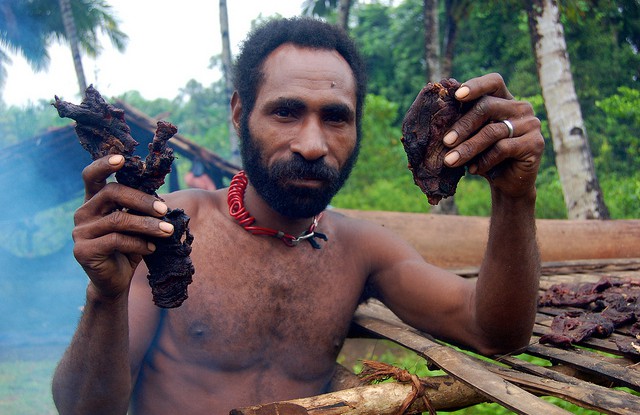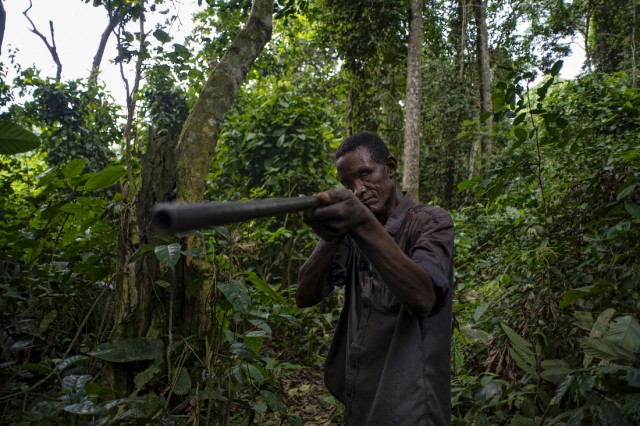
BOGOR, Indonesia—It’s one of the dark sides of the Asian economic boom.
Growing demand for wild meat and traditional medicine among Asia’s burgeoning urban middle class represents a grave threat to forest-based wildlife in the region and beyond, according to a new scientific review.
The authors of the review, published by the Center for International Forestry Research (CIFOR), write that education—and experimentation—will be needed to make a dent in a multibillion-dollar market plagued by unsustainability and racked with illegality.
Bushmeat—the hunting of forest-based animals for food and other purposes—has been a cornerstone of nutrition and culture for Asia for thousands of years. But while bushmeat was once consumed primarily by poor and rural communities, it is increasingly finding its way into the region’s more affluent urban centers, where attitudes toward bushmeat are changing. Some types of bushmeat are now being consumed—whether as food or as medicine—as a luxury item.
The CIFOR study reviews scientific literature on bushmeat in Asia, highlighting growing concerns among experts that unsustainable harvesting of bushmeat across the region represents a “major threat to the biodiversity” of forests in East and Southeast Asia.
“In the case of bushmeat, there was once an argument that it was necessary to address starvation or poverty in Asia, but Asia is not what it used to be,” said CIFOR scientist Miguel Pinedo-Vasquez, a co-author of the paper. “Because of development and new wealth, Asian nations now have to seriously think about reversing the depletion of wildlife species and degradation of forested land.”
“Asia should engage now, not just in trees but repopulating wildlife,” he said.
NO BAN, BUT MORE RESEARCH
The paper calls for testing potential solutions that do not simply impose a blanket ban on bushmeat hunting but that aim for sustainable consumption and trade that considers food security, livelihoods, health issues and local cultural values and knowledge.
Crucial to establishing a sustainable wildlife management system is understanding urban residents’ changing attitudes toward bushmeat consumption and identifying the social drivers of the wildlife trade, according to the paper, which highlights findings from a growing body of documentation of the demographics of urban bushmeat consumers.
In Vietnam, for example, wild meat is now widely consumed by high-income, high-status males of all ages and educational levels, and is used as a way of communicating prestige and obtaining social leverage, according to a study in the northern city of Hanoi, where the main reason given for not eating bushmeat is that it is “too expensive.”
But bushmeat is not just for eating.
The use of animal parts or products for medicinal purposes—from rhino horn to tiger penis to turtle jelly—has a long history in East and Southeast Asia and is so prevalent today that “traditional” Asian medicine is on a “collision course with wildlife preservation,” the authors write, citing a 2011 paper.
Clearly, the economic boom is making matters worse.
“With an increase in wealth and population, the medicinal market has grown too, so we are seeing higher pressure on animals like turtles and tigers to supply demand,” Pinedo-Vasquez said.
To get these countries to start thinking about sustainable use of wildlife, we have to go beyond what is legal and illegal, and come up with solutions that address these more complex issues
Asia’s development has also resulted in new routes for bushmeat to fill that demand.
While urbanization has improved infrastructure to aid economic growth, newly developed roads and transportation systems are also creating corridors for the trade of wildlife for food and medicine, both legal and illegal. Rural hunters are increasingly able to access international markets through these corridors, sending bushmeat and animal products to urban centers, from where the products are either consumed locally or, increasingly, sent overseas.
This phenomenon is seen in the Mekong Delta region of Southeast Asia, where protected areas provide the last refuges for wildlife and biodiversity in the area. But transportation infrastructure development and land conversion that encroaches on the boundaries of these areas threatens them further. “Realistic mitigation measures are needed to prevent these economic corridors from becoming wildlife trade superhighways,” according to one paper cited in the CIFOR review.
TURTLE POWER
The turtle trade is one example of just how far these economic corridors reach.
In China, turtles are highly sought for nutritional and medicinal purposes.
“The Chinese market for turtles is huge and is always going to be an incentive,” Pinedo-Vasquez said. “Turtles come from everywhere in Asia, and the ones from the wild have more value, so we are seeing them go from rural areas, to urban centers and then on to countries like China.”
“There are so many established networks in Asia to feed the Chinese market. Even hunters from as far as the Amazon ship turtles to China because the market is so big,” he said.
One potential solution the study’s authors propose is to test how sustainable substitutes, farmed or synthetic, are received by consumers who traditionally value turtle meat and products.
Public education is also recommended for explaining the harmful effects of consuming illegal wildlife products, the authors write. The authors, however, acknowledge the difficulty in influencing cultural attitudes toward such products, citing as an example a study in the Indian state of Nagaland, where wildlife laws have largely been ineffective due to cultural traditions of hunting for meat, perceived medicinal and ritual value, and community ownership of the forests.
“In many parts of Asia, these cultural practices, combined with lax law enforcement, means little is being done on the ground to make the trade sustainable,” Pinedo-Vasquez said. “In many places, if a law enforcement officer sees a family eating a monkey, instead of fining them, he might just join them and eat the monkey, because that’s what people traditionally do there.”
CAN CERTIFICATION WORK?
The paper cited a previously published report that recommended improving the knowledge base of species traded and educating consumers about the effects that demand for bushmeat and traditional medicine has on these species.
Certification schemes are also a potential solution to making the bushmeat and wildlife trades sustainable and should be tested, the paper suggests.
“To get these countries to start thinking about sustainable use of wildlife, we have to go beyond what is legal and illegal, and come up with solutions that address these more complex issues,” Pinedo-Vasquez said.
For more information on the topics of this research, please contact Miguel Pinedo-Vasquez at m.pinedo-vasquez@cgiar.org.
This study was supported in part by USAID, DFID and the CGIAR Fund. CIFOR’s research on bushmeat forms part of the CGIAR Research Program on Forests, Trees and Agroforestry.
We want you to share Forests News content, which is licensed under Creative Commons Attribution-NonCommercial-ShareAlike 4.0 International (CC BY-NC-SA 4.0). This means you are free to redistribute our material for non-commercial purposes. All we ask is that you give Forests News appropriate credit and link to the original Forests News content, indicate if changes were made, and distribute your contributions under the same Creative Commons license. You must notify Forests News if you repost, reprint or reuse our materials by contacting forestsnews@cifor-icraf.org.

